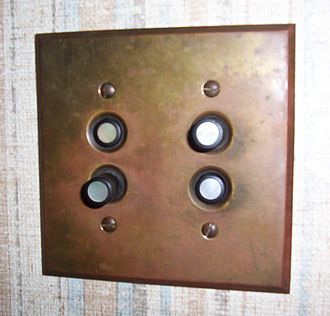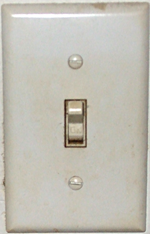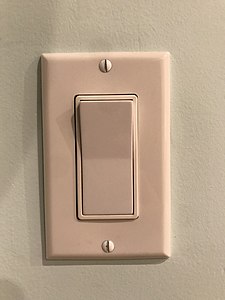The modern, everyday light switch is barely even 100 years old. Not surprising if you think about the fact that electric lights haven’t even been in homes for much longer than that. Yet, we hardly think about the humble light switch, which gives a lifetime of use for barely any cost, and which functions perfectly day after day. The only time we think about a light switch is when the power goes out and they suddenly stop working.
A light switch shouldn’t be tough to understand. It’s just a way to allow electricity to flow or not flow. And it should be as simple as that. But, early light switches were unsafe and unreliable. Without enough shielding, they had a tendency to shock people. What’s more, as they worked, they created little sparks which had a tendency to make the switch stop working as residue built up on it. Those sparks were also a fire hazard.
The solution was to create a light switch that closed the circuit so quickly that a spark couldn’t really form, and to encase it in something that wouldn’t transmit the electricity at all. There’s surprisingly little information on how this happened available on the internet. All available sources seem to agree that the concept of a “quick break light switch” came from a British inventor named John Henry Holmes. Holmes was a pioneer in electrical distribution, inventing some of the earliest systems for transmitting high voltage across distance.
In 1884, Holmes invented a light switch that worked quickly enough that there wasn’t a risk of sparks. His patents in the US and Britain helped move the entire idea of electrical distribution forward.
The modern light switch that most homes still have was patented in 1917. Again, there’s very little information about how it was invented, but we know it was William J. Newton who figured it all out.

Early light switches used push buttons like what you see above. These were very common in prewar homes, and you might even see them in homes today. They’ve become rarer, though, and seeing one tends to make you think that maybe the entire electrical system needs replacing. Still, the loud “click” of the switch is nostalgic for a lot of people.

The majority of light switches in use today look something like the toggle switch you see above. It’s been popular in the last 30 years or so to use the “decora” style as well, which looks like this:

For whatever reason, Americans associate this switch with looking more modern. In either case, the inner workings are pretty much the same. The contacts inside are kept apart until the switch is in the completely flipped position, which minimizes sparking. And, of course, the entire thing is encased in plastic so there is no danger of the user getting a shock.
If you’ve ever been to another country, you’ll notice that light switches vary depending on where you are. To some degree this is due to the standard shape of electrical boxes, which are defined differently by different governments. It’s common in much of the world for light switches to be square as opposed to tall, and in some parts of the world you see truly odd things like knobs or switches where the “down” position means “on.” No matter what they look like though, they all act the same.
The post Someone INVENTED It: Light Switch appeared first on The Solid Signal Blog.
Continue reading...
Understanding the problem of a light switch
A light switch shouldn’t be tough to understand. It’s just a way to allow electricity to flow or not flow. And it should be as simple as that. But, early light switches were unsafe and unreliable. Without enough shielding, they had a tendency to shock people. What’s more, as they worked, they created little sparks which had a tendency to make the switch stop working as residue built up on it. Those sparks were also a fire hazard.
The solution was to create a light switch that closed the circuit so quickly that a spark couldn’t really form, and to encase it in something that wouldn’t transmit the electricity at all. There’s surprisingly little information on how this happened available on the internet. All available sources seem to agree that the concept of a “quick break light switch” came from a British inventor named John Henry Holmes. Holmes was a pioneer in electrical distribution, inventing some of the earliest systems for transmitting high voltage across distance.
In 1884, Holmes invented a light switch that worked quickly enough that there wasn’t a risk of sparks. His patents in the US and Britain helped move the entire idea of electrical distribution forward.
Early light switches
The modern light switch that most homes still have was patented in 1917. Again, there’s very little information about how it was invented, but we know it was William J. Newton who figured it all out.

Early light switches used push buttons like what you see above. These were very common in prewar homes, and you might even see them in homes today. They’ve become rarer, though, and seeing one tends to make you think that maybe the entire electrical system needs replacing. Still, the loud “click” of the switch is nostalgic for a lot of people.
Today’s light switches

The majority of light switches in use today look something like the toggle switch you see above. It’s been popular in the last 30 years or so to use the “decora” style as well, which looks like this:

For whatever reason, Americans associate this switch with looking more modern. In either case, the inner workings are pretty much the same. The contacts inside are kept apart until the switch is in the completely flipped position, which minimizes sparking. And, of course, the entire thing is encased in plastic so there is no danger of the user getting a shock.
If you’ve ever been to another country, you’ll notice that light switches vary depending on where you are. To some degree this is due to the standard shape of electrical boxes, which are defined differently by different governments. It’s common in much of the world for light switches to be square as opposed to tall, and in some parts of the world you see truly odd things like knobs or switches where the “down” position means “on.” No matter what they look like though, they all act the same.
The post Someone INVENTED It: Light Switch appeared first on The Solid Signal Blog.
Continue reading...

